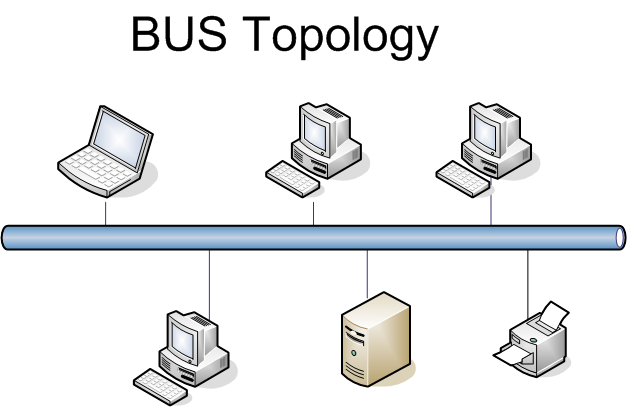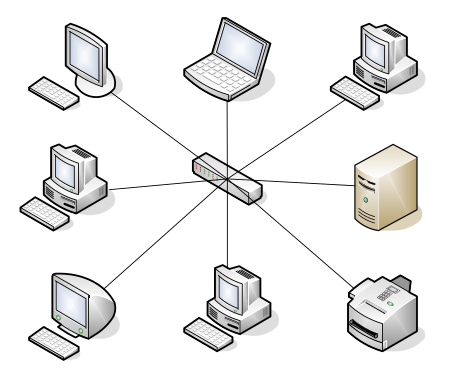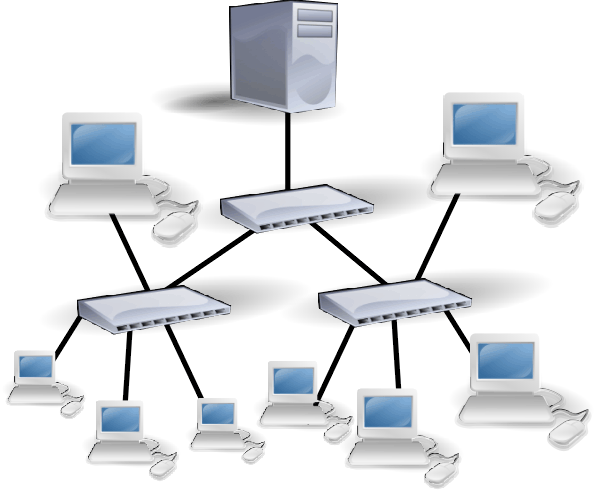What is Computer Networking?
A computer network is a group of interconnected devices that communicate and share resources. These devices include computers, printers, servers, and mobile devices. Networking allows data to be transferred efficiently and securely between users and systems.
Back to TopTypes of Networks
- LAN (Local Area Network): Covers a small geographic area like a home or office.
- WAN (Wide Area Network): Spans large areas such as cities or countries. The internet is the largest WAN.
- MAN (Metropolitan Area Network): Connects users across a city.
- PAN (Personal Area Network): Used for devices close to a person, like Bluetooth connections.
Common Networking Devices
- Router: Directs data packets between networks.
- Switch: Connects devices within the same LAN.
- Hub: A basic device that broadcasts data to all connected devices.
- Access Point: Extends wireless coverage within a network.
Network Topologies
Network topology refers to the physical or logical layout of the devices and cables (or wireless connections) that make up a network. It's essentially the network's "map," showing how devices—like computers, switches, and routers—are connected and how data flows between them. Understanding topologies is critical because the design of a network directly impacts its performance, scalability, cost, and fault tolerance.
There are two main categories:
- Physical topology: How the devices are physically connected (e.g., cables, hardware).
- Logical topology: How data actually travels through the network, regardless of the physical layout.
Here are the most common types of network topologies:
Bus Topology
- Description: All devices are connected to a single central cable (the "bus").
- Pros: Easy to set up, cost-effective for small networks.
- Cons: Difficult to troubleshoot, a failure in the main cable can take down the whole network.
- Use Cases: Used in small office networks or home network, in labs and classrooms, or as a segement of a larger network topology.

Umapathy, CC BY-SA 3.0, via Wikimedia Commons
Star Topology
- Description: All devices are connected to a central device like a switch or hub.
- Pros: Easy to manage, a failure in one device doesn’t affect the rest of the network. Higher performance as each device has a dedicated connection to the central hub/network switch.
- Cons: If the central device fails, the whole network goes down. Requires more cables, thus increasing oveall cost.

Umapathy, CC BY-SA 3.0, via Wikimedia Commons
Ring Topology
- Description: Devices are connected in a circular fashion, with data traveling in one or both directions.
- Pros: Predictable data path, good performance under light loads.
- Cons: A break in the ring can disrupt communication unless redundancy (like dual rings) is built in.

https://commons.wikimedia.org/wiki/File:Topolox%C3%ADa_en_anel.png, Public domain, via Wikimedia Commons
Mesh Topology
- Description: Every device is connected to every other device.
- Pros: Extremely reliable and fault-tolerant, as multiple paths exist for data.
- Cons: Expensive and complex to set up, especially in large networks.

Qeef, CC BY-SA 4.0, via Wikimedia Commons
Tree Topology
- Description: A hybrid topology combining characteristics of star and bus topologies.
- Pros: Scalable and easy to manage in hierarchical structures.
- Cons: If a backbone segment fails, connected branches may go down.

https://commons.wikimedia.org/wiki/File:Topolox%C3%ADa_en_%C3%A1rbore.png, Public domain, via Wikimedia Commons
Hybrid Topology
- Description: A combination of two or more topologies tailored to fit specific needs.
- Pros: Flexible and customizable.
- Cons: Can be complex and more expensive to design and maintain.
Why Topology Matters
Choosing the right topology is a foundational decision in network design. It affects everything from network reliability and speed to ease of expansion and troubleshooting. For example, while a star topology is common in modern LANs for its simplicity and resilience, mesh topologies are favored in environments where uptime and redundancy are critical, such as data centers or military applications.
Understanding topologies is also key for certification exams like CompTIA Network+, where questions often involve recognizing topologies and selecting appropriate ones based on given scenario
Back to TopWired vs. Wireless Networks
When building or using a network, one of the first decisions you'll encounter is whether to use wired or wireless connections—or a mix of both. Each has its strengths and trade-offs depending on the environment, purpose, and user needs. Wired networks use Ethernet cables to connect devices, offering speed and stability. Whereas, wireless networks use radio signals (Wi-Fi) for flexibility and mobility but may face interference or speed limitations.
Wired Networks
Wired networks use physical cables (like Ethernet) to connect devices such as computers, printers, switches, and routers. These cables transmit data through electrical signals.
Common Wired Technologies:
- Ethernet (Cat5e, Cat6, Cat6a, Cat7): Most commonly used in homes and offices.
- Fiber Optic: Transmits data as light; used for high-speed backbone connections and long distances.This is quite expensive compared to copper Ethernet cabling and is often uses in large business networks.
Advantages:
- Speed and Reliability: Offers faster and more stable connections, especially for tasks like streaming, gaming, and large file transfers.
- Security: Less susceptible to unauthorized access, as someone needs physical access to the network cable to intercept data.
- Low Interference: Not affected by walls, microwaves, or other wireless signals.
Disadvantages:
- Limited Mobility: Devices must be physically tethered to the network, which can restrict movement and placement.
- Installation Complexity: Requires running cables through walls or ceilings, which can be time-consuming and costly.
- Scalability: Adding new devices often involves running additional cables.
Wireless Networks
Wireless networks (Wi-Fi) use radio waves to transmit data without physical cables. Devices connect via wireless access points (APs) to the main network.
Common Wireless Standards:
- 802.11n (Wi-Fi 4) – Up to 600 Mbps
- 802.11ac (Wi-Fi 5) – Up to several Gbps, depending on the hardware
- 802.11ax (Wi-Fi 6) – Improved speed, range, and capacity for modern devices
Advantages:
- Mobility: Users can move freely with laptops, tablets, and smartphones while staying connected.
- Convenient Installation: No cables required, making setup quicker and less disruptive.
- Flexibility: Easy to expand or modify the network as needed.
Disadvantages:
- Signal Interference: Wi-Fi signals can be affected by walls, electronics, and other wireless devices.
- Speed and Stability: Generally slower and less stable than wired connections, especially in crowded environments.
- Security Risks: More vulnerable to eavesdropping and unauthorized access if not properly secured (e.g., weak Wi-Fi passwords, outdated encryption).
The best choice between the two often depends on the situation:
- Homes and Small Offices: Wireless offers flexibility and convenience, while wired connections are great for desktop computers or entertainment systems that need stability.
- Large Offices or Data Centers: Often use a mix—wired for backbone connections and servers, wireless for employee mobility.
- Public Spaces: Wireless is essential, but must be secured to prevent unauthorized access.
OSI Model
The OSI (Open Systems Interconnection) and TCP/IP models to provide a framework for understanding how data flows through a network.
- Descriptions of each layer and its functions.
- Examples of protocols associated with each layer.
- Comparisons between the OSI and TCP/IP models.
This foundational knowledge is crucial for troubleshooting and understanding network operations. To truly grasp how computer networks operate, it's essential to understand the OSI (Open Systems Interconnection) model. The model act as frameworks that describe how data moves from one device to another across a network. See the article The OSI 7-Layer Model to learn more.
Back to TopCommon Networking Protocols and Ports
Networking protocols are the rules and standards that allow devices to communicate over a network. Whether you're browsing a website, sending an email, or streaming a video, specific protocols are working behind the scenes to ensure your data gets where it needs to go. Each protocol operates on specific port numbers, which act like doors through which data enters or exits a device. Understanding these protocols and their associated ports is crucial for anyone learning how networks function or preparing for certifications like CompTIA Network+. Explore the most commonly used protocols and their port numbers in our full guide.
Back to Top

